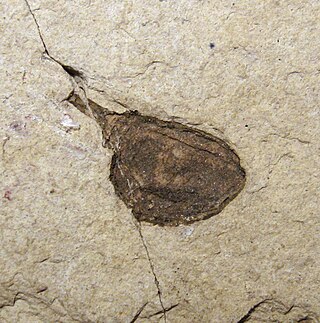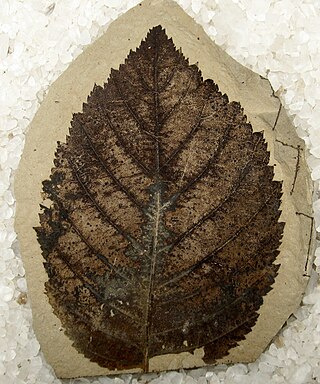
Eucommia ulmoides is a species of small tree native to China. It belongs to the monotypic family Eucommiaceae. It is considered vulnerable in the wild, but is widely cultivated in China for its bark and is highly valued in herbology such as traditional Chinese medicine.
Paleontology or palaeontology is the study of prehistoric life forms on Earth through the examination of plant and animal fossils. This includes the study of body fossils, tracks (ichnites), burrows, cast-off parts, fossilised feces (coprolites), palynomorphs and chemical residues. Because humans have encountered fossils for millennia, paleontology has a long history both before and after becoming formalized as a science. This article records significant discoveries and events related to paleontology that occurred or were published in the year 1930.
Neviusia dunthornei is an extinct species of flowering plants in the family Rosaceae. The species is solely known from the early Eocene, Ypresian stage, Allenby Formation Lacustrine deposits near the town of Princeton, British Columbia.

Eucommia is a genus of small trees now native to China, with a fossil record that shows a much wider distribution. The single living species, Eucommia ulmoides, is near threatened in the wild, but is widely cultivated in China for its bark, and is highly valued in herbology such as traditional Chinese medicine.

Eucommia eocenica is an extinct species of flowering plant in the family Eucommiaceae. E. eocenica is known from fossil fruits found in the middle Eocene Claiborne Formation deposits of the southeastern United States. E. eocenica is one of five described fossil species from North America assigned to the modern genus Eucommia. The other species are E. constans, E. jeffersonensis, E. montana, and E. rowlandii.

Eucommia montana is an extinct species of flowering plant in the family Eucommiaceae. E. montana is known from fossil fruits found in Eocene deposits of the northwestern United States southeastern British Columbia south to Oregon and east to Montana and Colorado. E. montana is one of five described fossil species from North America assigned to the modern genus Eucommia. The other species are E. constans, E. eocenica, E. jeffersonensis, and E. rowlandii.
Eucommia constans is an extinct species of flowering plant in the family Eucommiaceae. Eucommia is a genus of small trees now native to China, with a fossil record that shows a much wider distribution. E. constans is known from fossil fruits found in Miocene to Pleistocene deposits of east-central Mexico. E. constans is one of five described fossil species from North America assigned to the modern genus Eucommia. The other species are E. eocenica, E. jeffersonensis, E. montana, and E. rowlandii.
Eucommia jeffersonensis is an extinct species of flowering plant in the family Eucommiaceae. It is known from a fossil fruit found in latest Eocene deposits of Oregon, United States. E. jeffersonensis is one of five described fossil species from North America assigned to the modern genus Eucommia. The other species are E. constans, E. eocenica, E. montana, and E. rolandii.
Acer ivanofense is an extinct maple species in the family Sapindaceae described from series of isolated fossil leaves. The species was described from Eocene to Oligocene aged fossils found in the United States of America. It is one of several extinct species placed in the living section Glabra.

Orontium wolfei is an extinct golden-club species in the family Araceae described from a series of isolated fossil leaves. The species is known from Eocene sediments exposed in the state of Washington in the United States of America and the province of British Columbia in Canada. It is one of several extinct species placed in the living golden-club genus Orontium.

Rhus malloryi is an extinct species of flowering plant in the sumac family Anacardiaceae. The species is known from fossil leaves found in the early Eocene deposits of northern Washington state, United States. The species was first described from a series of isolated fossil leaves in shale. R. malloryi is one of four sumac species to be described from the Klondike Mountain Formation, and forms a hybrid complex with the other three species.

Tsukada is an extinct genus of flowering plant in the family Nyssaceae related to the modern "dove-tree", Davidia involucrata, containing the single species Tsukada davidiifolia. The genus is known from fossil leaves found in the early Eocene deposits of northern Washington state, United States and a similar aged formation in British Columbia, Canada.
Acer lincolnense is an extinct maple species in the family Sapindaceae described from a group of fossil leaves and fruits. The species is known from Eocene sediments exposed in the US state of Montana. It is tentatively placed into the living Acer section Cissifolia.

Ulmus okanaganensis is an extinct species of flowering plant in the family Ulmaceae related to the modern elms. The species is known from fossil leaves, flowers, and fruits found in the early Eocene deposits of northern Washington state, United States and similar aged formations in British Columbia, Canada.

Betula leopoldae is an extinct species of birch in the family Betulaceae. The species is known from fossil leaves, catkins, and inflorescences found in the early Eocene deposits of northern Washington state, United States, and similar aged formations in British Columbia, Canada. The species is placed as basal in Betula, either as a stem group species, or an early divergent species.

Rhus boothillensis is an extinct species of flowering plant in the sumac family Anacardiaceae. The species is known from fossil leaves found in the early Eocene deposits of northern Washington State, United States. The species was first described from fossil leaves found in the Klondike Mountain Formation. Rhus boothillensis likely hybridized with the other Klondike Mountain formation sumac species Rhus garwellii, Rhus malloryi, and Rhus republicensis.

Rhus garwellii is an extinct species of flowering plant in the sumac family Anacardiaceae. The species is known from fossil leaves found in the early Eocene deposits of northern Washington State, United States. The species was first described from fossil leaves found in the Klondike Mountain Formation. R. garwellii likely hybridized with the other Klondike Mountain formation sumac species R. boothillensis, R. malloryi, and R. republicensis.
Rhus republicensis is an extinct species of flowering plant in the sumac family, Anacardiaceae. The species is known from fossil leaves found in the early Eocene deposits of northern Washington state in the United States. The species was first described from fossil leaves found in the Klondike Mountain Formation. R. republicensis likely hybridized with the other Klondike Mountain formation sumac species Rhus boothillensis, Rhus garwellii, and Rhus malloryi.
Paraconcavistylon is an extinct genus of flowering plant in the family Trochodendraceae comprises a single species, Paraconcavistylon wehrii. The genus is known from fossil fruits and leaves found in the early Eocene deposits of northern Washington state, United States, and southern British Columbia, Canada. The species was initially described as a member of the related extinct genus Concavistylon as "Concavistylon" wehrii, but subsequently moved to the new genus Paraconcavistylon in 2020 after additional study.

Barghoornia is an extinct genus of flowering plants in the family Burseraceae containing the solitary species Barghoornia oblongifolia. The species is known from fossil leaves found in the early Eocene deposits of northern Washington state, United States.










